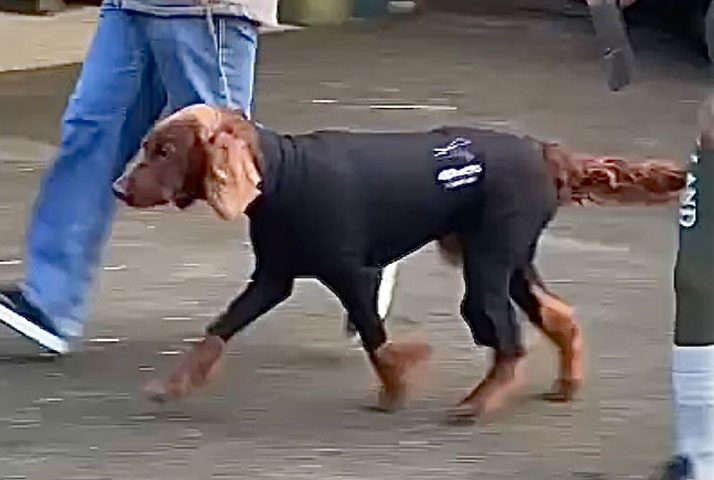Irish Setter with inconsistent symptoms and crabwalk

Kate with Non, seven-year-old Irish Setter dog, Great Britain
“Non is a seven-year-old Irish Setter bitch who successfully participated in shows and thereby also received her stud book number. With her enormous activity and tireless willingness to run and hunt in all conditions, she undoubtedly meets her breed’s standard. She also showed a free flowing, perfectly coordinated movement with real action when viewed from the front or rear and in profile. When she moved in the ring, we even had the impression she was floating, and we loved to follow her movements.
But then we suddenly noticed that her movements were no longer straight and even and, due to our inexperience, we thought it might be a case of crab walking. So, we tried to solve the problem using many different training techniques but had little success. Then, when we observed Non on sandy ground, it became clear that she was not moving evenly on all legs. After trying many different methods, we decided to use acupuncture, which was successful but short-lived in terms of its effect.
In addition to this uneven pressure on all of her four legs, we noticed that Non was not carrying her head properly. When we tried to stroke her, she clearly avoided any head touch. The difficulty we had in identifying the causes of her problems stemmed from the fact that the symptoms were inconsistent and never lasting in their clarity. We could not find an answer to the question of why she had abruptly started demonstrating these abnormalities in her movements and behaviour.
Finally, we were invited by our animal physiotherapist (CS Animal Physiotherapy) to participate in the LupoGait® trial and were immediately excited about the clearly discernible difference the experience made for Non. First and foremost, we were grateful that she did not have to endure a sedation examination, but instead only had to travel a short distance with her owner, which is ideal for a dog that suffers from separation anxiety.
In general, the whole procedure was very simple, but the results were almost instantaneous. This may seem impossible, but that is exactly what happened. Once the computer data had been interpreted, our dog was treated with the necessary physiotherapy by Ceri Simpson (Physio) and by the end of the first session I could already see a clear improvement in Non’s overall behaviour. She left the clinic with her head held high, looking so much better and moving with ease. At that moment I realised how restricted her movement had been before and it saddened me to imagine that she might have continued to move in this painful way if she had not been given the opportunity to participate in this study.
It was determined that there were two areas of her anatomy that needed treatment. Firstly, there needed to be a correction to Non’s hindquarters movements and secondly, the way she held her head required improvement. The positive results were evident from the beginning, but due to an injured foot, it was not possible for Non to continue the treatment. During this time, the improved movement of the hindquarters was maintained. However, the same could not be said of her head. Non was again able to show immediate improvement immediately following further data collection, analysis, and resumption of treatment. This is no exaggeration! This result was also achieved without any x-rays, scans, or anaesthesia.
Our girl Non has really benefited from LupoGait® and I cannot praise the procedure enough. In fact, I have already recommended it via social media. We have been very fortunate, thanks to Ceri Simpson and LupoGait®, to be able to solve a problem that was thought to be unsolvable. Now we want other dog owners to have the opportunity to experience this good fortune by having access to this excellent diagnostic tool.”
«Share your favourite article with your colleagues»
